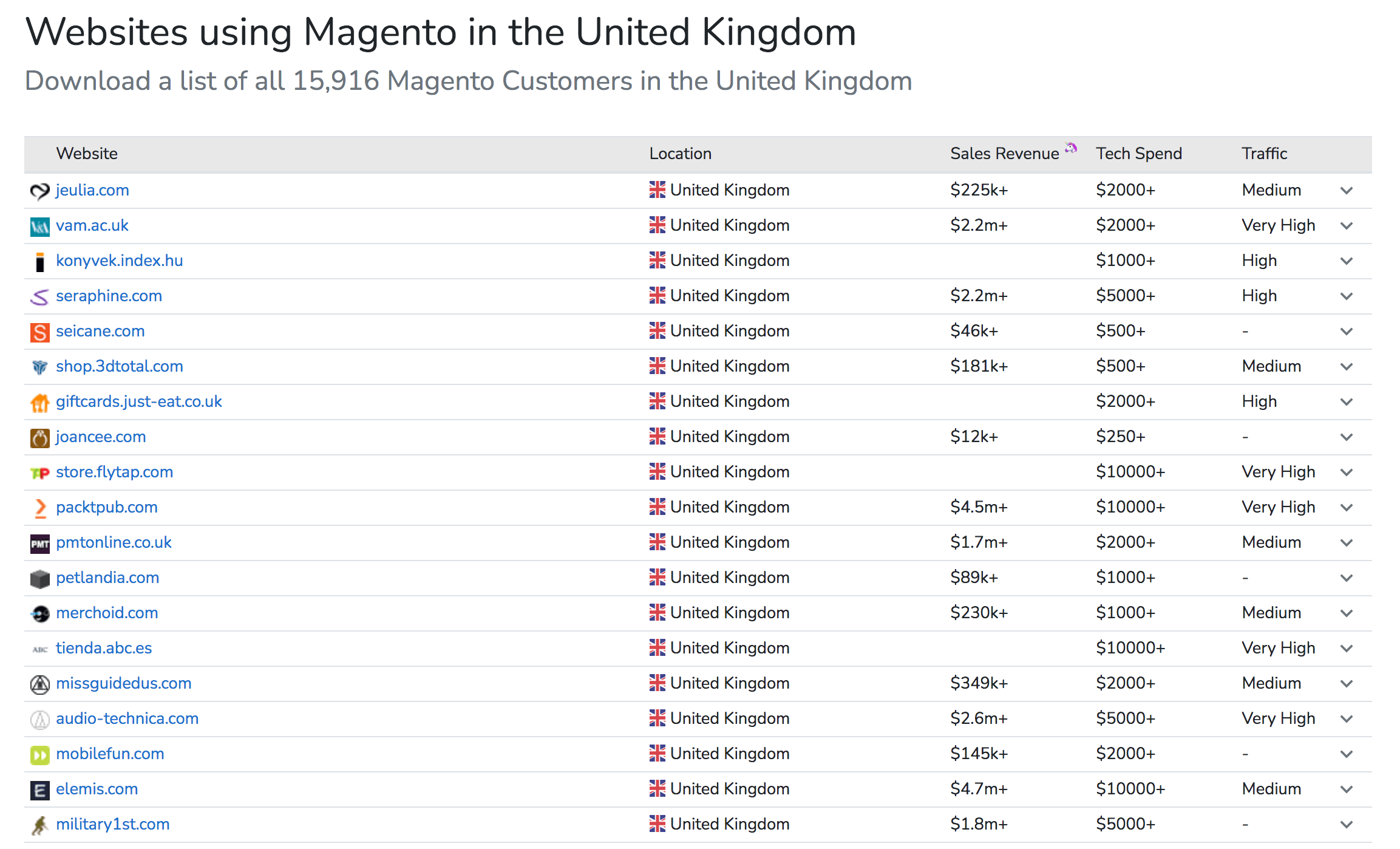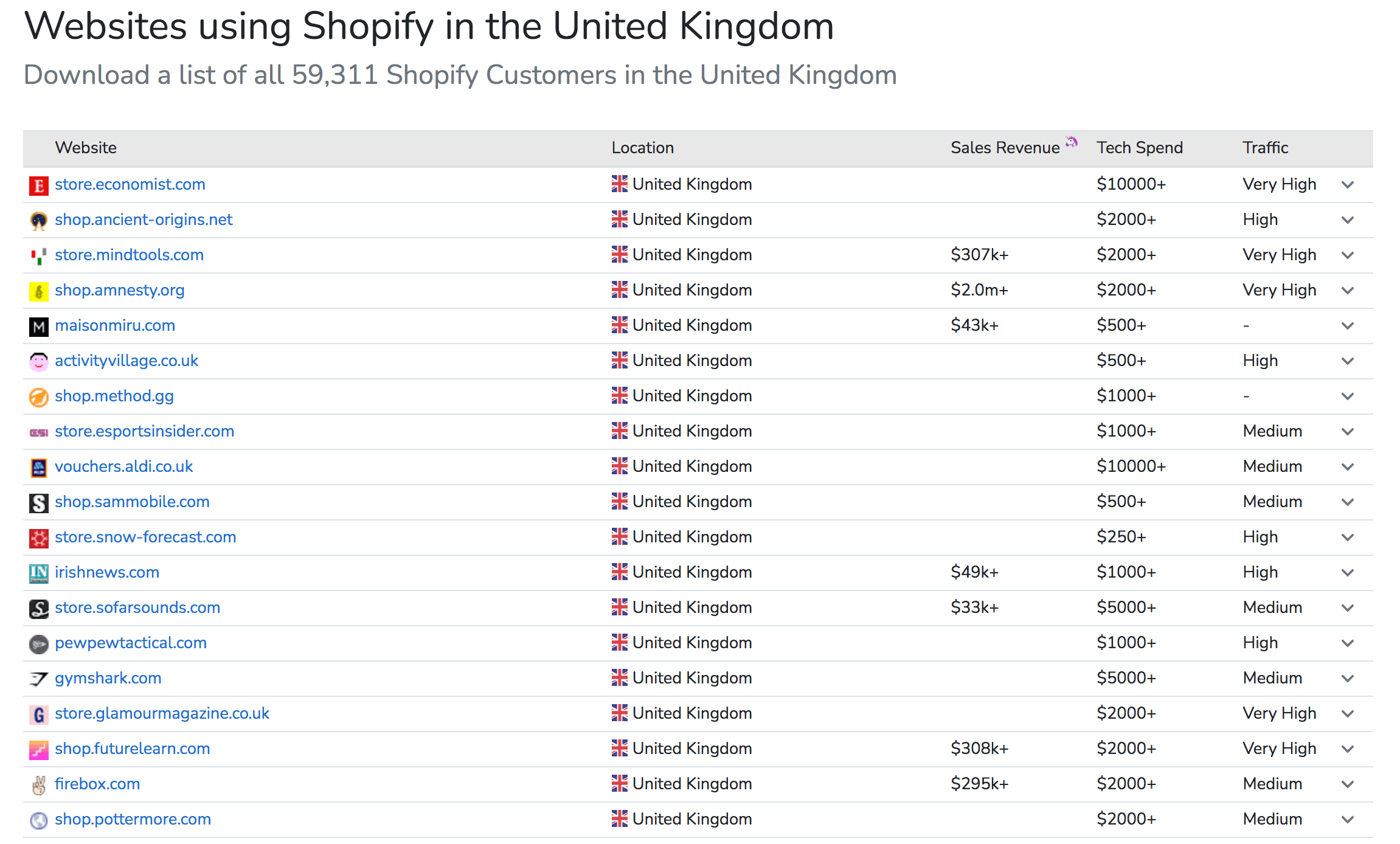TECHNOLOGIES
INDUSTRIES
Need assistance? Talk to the expert

MageCloud Customers
Discover how ecommerce businesses worldwide use MageCloud to power their success.
Magento and Shopify are two of the most popular platforms when it comes to online business. Your online business must get the right eCommerce platform for your website from the start.
Are you considering starting an online shop? or maybe you are planning to migrate your current one to another eCommerce platform? – and you have just started looking at the different options available?
Choosing the right platform is a crucial factor in terms of whether your business gets off to a good and hassle-free start so that it can develop successfully.
Limited resources and liquidity are often issues that will easily fill up if the solution you have chosen is not optimal, and especially for smaller companies, this can be crucial for whether you can develop and run your business.
Shopify and Magento 2 are the most popular platforms for eCommerce. The purpose of this guide is to help you get the most out of your decision-making process and, at the same time, provide answers to frequently asked questions.
How many people use Magento in the UK? 15,916 webshops. |
How many people use Shopify in the UK? 59,311 webshops. |
 |
 |
[Source https://trends.builtwith.com]
Shopify is the leading cloud software on the market for “hosted, all-in-one”. This solution is predefined, which means that the source code is locked. With a Shopify solution, you do not own the source code as you do with a Magento solution.
The Magento platform is specifically developed for eCommerce and it is the largest provider of software for webshops. A Magento solution gives you free opportunities to change various designs that suit your business.
Other differences in the two solutions that are worth paying attention to are:
Shopify and Magento both offer individual solutions that are suitable for all large, small, and medium-sized businesses. For larger companies, these solutions are Magento Enterprise and Shopify Plus respectively.
In this guide, we have chosen not to focus on these solutions, as very few eCommerce start-ups use these versions.
If you want a platform that is geared and future-proof in terms of conducting powerful eCommerce, we recommend that small and medium-sized companies choose the Open Source version of Magento, Magento Commerce, as this solution can handle large amounts of data and is designed for growth.
Keypoints Magento |
Keypoints Shopify |
|
|
Shopify and Magento both offer user-friendly features.
Basic features such as a shopping cart, checkout (order summary, customer information, shipping options, payment options), catalogs, and product pages are included in both Magento and Shopify.
What is the biggest difference between the two systems? Magento has more advanced built-in features than Shopify. Such as Multistore and SEO settings. If you want more advanced options in Shopify in addition to the standard functions, the functions must be purchased as an extension in the Shopify App Store.
Shopify offers a large selection of great themes and templates on Shopify Themes.
The selection of themes and templates for Magento is also huge, where you can easily find modern themes and templates, so you get a nicely designed shop that is user-friendly and conversion-optimized.
With Magento, you have access to the source code, which gives you the option to change the design and make your shop unique compared to competing sites, without compromising on the basic CTA (call to action) features for sure.
At Magento Marketplace, you can find a large selection of different themes, templates, and extensions for your Magento shop. In addition to Magento’s marketplace, there are other sites where you can purchase Magento themes and extensions.
Both Magento and Shopify offer Premium themes. However, many of their Premium themes are most often associated with high costs, while at the same time, Magento Premium themes can be purchased for significantly lower costs.
By default, Shopify is delivered in one language. If you need a multilingual website, you have to purchase and integrate an extension for this. Another option is to have a Shopify developer who can customize your site so that the site can handle multiple languages.
Magento has built-in multilingual support by default.
Both platforms allow flexible and efficient calculation of shipping costs.
You do not have the option to create discount codes or coupons in the Shopify Lite Plan. It is possible in all the other Shopify versions. Discount codes/coupons are standard in Magento. The function allows the creation of simple but advanced conditions.
Shopify supports over 70 payment gateways, with Magento supporting a lower number of gateways. Many payment gateways such as Bambora, Quickpay, Clearhaus, Pensopay, Dibs, Mobilepay, etc. can be added to Magento via 3-part modules.
The downside of Shopify is that you are forced to use the payment gateways that Shopify offers and do not have a free choice in payment gateways, as with Magento.
When you use Shopify’s own Shopify Payments, you pay 0% in transaction fees. Should you wish to use a recognized UK 3-party payment gateway, Shopify will charge an extra fee per transaction.
If you want more stores connected to one webshop solution, Magento is preferable to Shopify. If you regularly add new products to the catalog, it can be a challenge to do this when you have several stores in your shop (under admin). It is also problematic in relation to stock management as well as order processing and returns processing if you choose a Shopify solution.
Integrating financial systems or POS for every business in Shopify can also be a problem.
See the details of Shopify Pos, or read more about the possibilities within Magento Pos.
Magento is a Rolls Royce edition when it comes to handling Multi Stores. It can do it all and has an extremely well-developed engine to manage several shops under the same administration, which is why Magento is also particularly suitable when selling for both B2B and B2C. One can have one design that caters to B2B and another to B2C, but still with shared admin, warehouse, views, attributes, etc.
Shopify and Magento have no restrictions on the number of products created in the webshop. It is easy to create products and variables as well as catalogs on both platforms.
Ranking means the world to a webshop, and both Shopify and Magento are two platforms designed to take SEO into account, as both solutions have SEO tools and settings that make search engine optimization easy.
SEO helps increase the amount of visitor traffic from search engines to your site, which means more paying customers are coming.
Shopify includes the key SEO features that most of the other eCommerce platforms also offer. For example, editable title tags, 301 redirects, meta information and automatic sitemap generation.
If you want more advanced SEO features for your Shopify shop, you need to purchase extensions. There is an SEO Manager app with a friendly user interface, which gives you control over the shop’s SEO, where you pay a monthly fee ($20/month) to use the app.
The downside of Shopify SEO is that it requires a lot of work on your side.
There is a range of SEO tools that are desirable for any online business. But with Shopify, users cannot control the software or the hosting environment, and you will not be able to control these aspects.
If you want to scale your business, you may find this a significant limitation.
In Shopify, for example, you do not have access to the robot.txt file. Sitemaps are generated automatically and are usually not editable. If your business grows to a certain size, you may want to manage these elements to increase the ranking in the search engines. With Magento, you will never encounter these limitations.
Magento is a great example of how an eCommerce platform is to be designed to handle webshop SEO 100%. Magento gives you full control over everything in the system, which means you can set things up the way you want.
Magento allows you to change the default settings and fully customize the shop. You can customize your online shop’s SEO features, change the default meta tags, and restrict search engines from indexing pages you do not want to be ranked. You can edit image tags (helps Google understand how to categorize an image on the image search platform), page titles, etc., and customize URLs to help users find your web pages more easily in search engines.
If you have limited knowledge of programming and SEO features, be aware that you will need to modify the robot.txt file and meta robot directives to allow indexing by search engines. If you don’t, your website will not be indexed and the shop will not be ranked in Google.
Read more about what we can offer in Magento SEO or Shopify SEO.
Already on Magento? Find our technical SEO checklist for your Magento store on our blog.
Both platforms offer the ability to customize the shop using an advanced interface. You can edit in the raw HTML/CSS, however, it requires you to be 100% sure of what you are doing when working in the HTML/CSS tags.
In Shopify, you can easily work with basic attributes in your store via a menu, such as fonts, colors, etc. However, the customization options are greater in Magento, because the code is open-source, which means you can change the design to what you want, no restrictions here.
Shopify has a theme editor that allows you to change the theme. It is possible to work with the designed backend until you are ready to display that frontend.
Shopify has an integrated blog feature. Magento does not have it by default, you have to integrate a blog extension for that. Another option is to integrate the WordPress blog on Magento.
Every online shop must be appealing, easy to navigate, and it means having the right theme. The shop must be user-friendly and stand out from the crowd.
Shopify has many custom themes to choose from. They are easy to use and optimized for both computer and mobile devices. Shopify has a lot of free themes, but it may be necessary to buy more from Shopify Premium themes.
There is a large selection of Shopify themes with beautiful designs, so it should be possible to find just the design that suits your shop.
By default, Magento 2 comes with the default theme “Luma”. Very few people choose Magento’s default design. Usually, Magento users choose responsive themes that are more unique. You can find Magento themes in many different marketplaces that sell themes and templates as well as extensions for webshops.
With Magento, you also have the opportunity to implement your theme and update the design backend into the system. However, this should preferably take place on a test server to test the design before it goes online.
If you choose to have your webshop developed by a professional Magento developer, you must always make sure that the web agency has a test server where all the updates are processed on before being sent to live.
As mentioned, Shopify and Magento are both optimal platforms for eCommerce. Both have a well-designed and well-thought-out user interface, making it relatively easy for any user to get started with either Magento or Shopify.
Since Magento is not a hosted eCommerce solution, you need to find a hosting provider yourself, unless you have chosen a developer to take care of this and design your Magento 2 store.
With Shopify, you have the option of direct integration for dropshipping such as Oberlo, Printful, Spocket, and other exciting dropshipping suppliers via Dropshipping Shopify. But be aware that with a Shopify dropshipping solution, you have limitations on prices and currencies, which has an impact on your pricing when selling via omnichannel.
With Magento dropshipping, there are no restrictions here, you have full control over pricing, currency, and product description.
Contact MageCloud at [email protected] and hear more about what you can do with Dropshipping in Magento and Shopify.
Shopify offers a 14-day free trial. During the 14 days, you can test and evaluate functionality and features. Then you have to pay a monthly fee to use their service and platform.
Shopify offers different plans to choose from.
The scraped-out version Shopify Lite for $9/month and not least the large chrome-plated and professional solution Shopify Plus, which starts from $2,000/month.
Magento is completely free to use, with no service fee, etc. But, costs must be expected for hosting your Magento store. There are many different types of servers for Magento. However, the server must meet certain criteria to host Magento sites.
It is always good to research the market and talk to the various Magento hosting companies and hear what they can offer. If you have a skilled Magento developer, we recommend you rely on his experience in terms of what type of server you should use.
Most of MagecCloud’s customers in the UK use UKfast hosting, which has fantastic service.
Also, our customers use Nexcess, MageMojo, Rackspace, Cloudways, and other hosting providers.
Shopify does not charge additional transaction fees if you use Shopify Payments. If another gateway or method is used, the transaction fee is as follows:
(Prices as of Feb 1, 2021)
With Magento Open Source, no transaction fees are charged except for the payment gateway provider’s fees (which vary from gateway to gateway). Of course, these fees will also apply to Shopify.
Both platforms offer a large number of free as well as paid themes with Shopify (from $ 80) and Magento (from $ 1).
Shopify and Magento have much to offer when it comes to expanding the functionality of your site with additional apps and add-ons.
You can add most apps/extensions just with one click. It can give you access to the extensions that build trust. Access to extensions that can help you minimize the risk of abandoned carts, for example. Or you can integrate Shopify Instashop.
You can expand your CMS and eCommerce solution no matter what you choose.
Magento has thousands of free and paid extensions to choose from. You are not a developer? Then you can still add a lot of functionality to your Magento webshop despite the lack of coding knowledge.
You can add gift cards and gift wrapping to your shop e.g. There is also the option to implement a pre-order function and many other tools that can make it easy to run your business.
Whether you want to improve your order management capabilities or expand your market share, doing this with Magento is incredibly easy.
Shopify often appears to be a good solution, in terms of the range of apps and extensions. But Shopify simply can not compete with Magento when it comes to the range of extensions.
When comparing BigCommerce, WordPress/WooCommerce, Magento, Shopify, and many other eCommerce solutions, make sure you can operate with many different payment solutions such as MobilePay, Apple Pay, Mastercard, Visa, etc., to be sure that your shop is well covered with the most preferred payment methods.
Magento and Shopify enable you to receive online credit payments and other transactions from your customers. Shopify even has its own integrated payment gateway – Shopify Payments. If you use it, you do not have to pay transaction fees, but you do in case you choose the 3-party payment gateway.
Alternatively, if you prefer to use a payment solution that your customers are already familiar with, you can still use gateways like Bambora, Dibs, Quickpay, and PayPal.
Shopify supports more than 100 different external payment gateways.
With Magento, there are also many different payment gateways to choose from. But you need a developer for this task to be sure that everything is set up correctly between the shop and the payment gateway.
Magento supports over 150 payment gateways. Moreover, as previously mentioned, Magento supports multilingual stores, thus you can get payment options in many different languages and sell to customers from many countries.
So, at first glance, Shopify may be the best solution when it comes to quick and easy implementation of payment gateways, but with Magento, you have more options for international sales.
Hopefully, you have got useful info on what the main similarities and differences are between Magento and Shopify. And probably you have already decided which e/Commerce platform to choose in your specific case.
***
If you want to know how MageCloud can help your eCommerce business, please contact us to start discussing your needs.